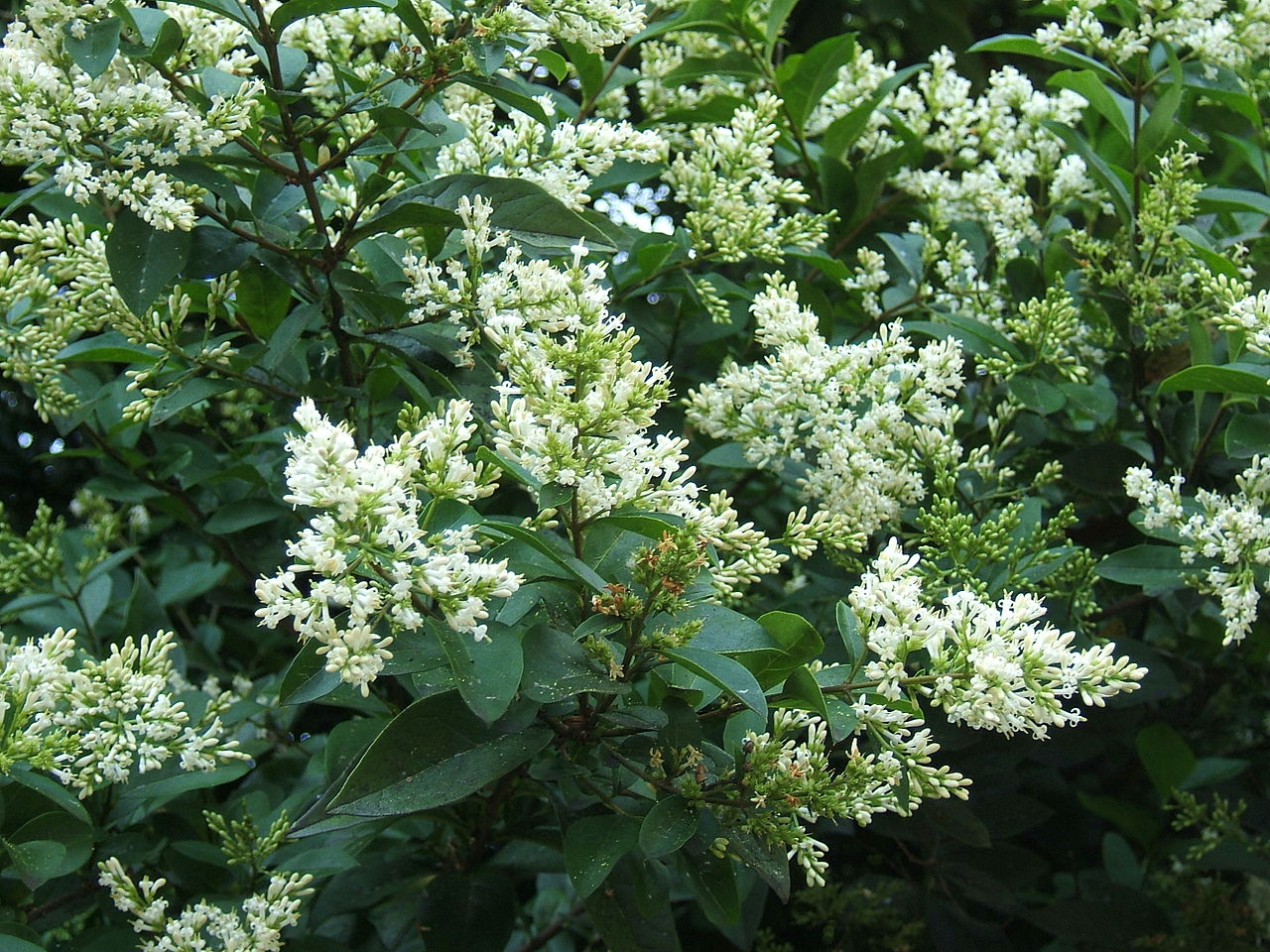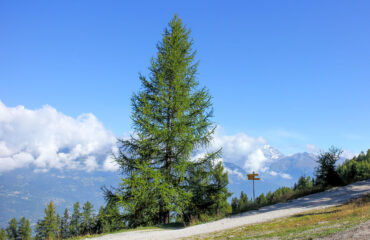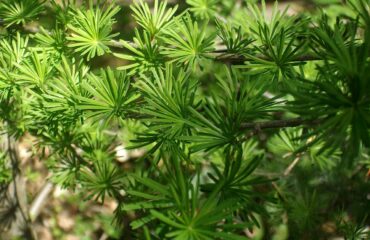Ligustrum, commonly known as Privet, is a genus of evergreen, semi-evergreen, and deciduous shrubs and small trees in the Oleaceae family. Native to Europe, Asia, and North Africa, Ligustrum species are widely cultivated for their dense, bushy foliage and their ability to form effective hedges and screens. The leaves are typically small, oval, and dark green, providing a lush, dense cover that is easy to trim and shape. In late spring to early summer, Ligustrum produces clusters of small, fragrant white flowers, followed by small black or dark purple berries that attract birds. Popular species include Ligustrum vulgare (Common Privet), Ligustrum japonicum (Japanese Privet), and Ligustrum lucidum (Glossy Privet). Depending on the species and growing conditions, Ligustrum can grow to a height of 6-15 feet (1.8-4.5 meters) and a spread of 6-8 feet (1.8-2.4 meters).
Preferred Growing Conditions:
- Soil Type: Prefers well-drained, moderately fertile soil; thrives in a mix of loamy soil enriched with organic matter. Tolerates a wide range of soil types, from sandy to clay.
- Sunlight: Grows best in full sun to partial shade; requires at least 4-6 hours of direct sunlight daily for optimal growth and flowering. Can tolerate light shade.
- Temperature: Hardy in USDA zones 5-10 depending on the species; tolerates cold winters and warm summers. Some species are more cold-hardy than others.
- Water Needs: Moderate; requires regular watering to keep the soil consistently moist but not waterlogged, especially when young. More drought-tolerant once established.
Ligustrum (Privet) Propagation Methods:
1. Stem Cuttings:
Stem cuttings are the most common and effective method for propagating Ligustrum, allowing for the production of new plants that retain the characteristics of the parent.
- Types of Cuttings:
- Use softwood cuttings taken in late spring to early summer or semi-hardwood cuttings taken in late summer to early autumn when the plant is not actively growing.
- Preparation:
- Select healthy, non-flowering shoots and cut 4-6 inch sections just below a leaf node.
- Remove the lower leaves, leaving only the top few pairs of leaves on the cutting.
- Optionally, dip the cut end in rooting hormone to encourage faster rooting.
- Planting:
- Insert the cuttings into a well-draining potting mix, such as a blend of peat and perlite or a commercial rooting mix.
- Water lightly to settle the soil and place the pot in a bright, indirect light location.
- Cover the pot with a plastic bag or place in a propagation tray with a clear lid to maintain high humidity.
- Rooting:
- Roots should begin to form within 6-8 weeks.
- Once roots are established and new growth appears, gradually acclimate the cuttings to lower humidity.
- Transplant the rooted cuttings into individual pots or directly into the garden.
2. Seed Propagation:
Growing Ligustrum from seeds is possible and allows for natural variation, but it can be slower than other methods. This method is often used for large-scale propagation or for producing plants with genetic diversity.
- Seed Collection and Preparation:
- Collect seeds from mature berries in late fall to early winter. Clean the seeds to remove any pulp and dry them for a few days.
- Seeds may benefit from stratification. Place seeds in a moist medium (such as sand or peat moss) and refrigerate at around 35-40°F (1.5-4°C) for 2-3 months to break dormancy.
- Sowing Techniques:
- After stratification, sow seeds in seed trays or small pots filled with a light, well-draining seed-starting mix.
- Sow the seeds on the surface and cover lightly with a thin layer of soil or sand.
- Keep the soil consistently moist but not waterlogged.
- Place the trays in a bright location with temperatures around 65-75°F (18-24°C).
- Germination Requirements:
- Seeds typically germinate within 3-6 months under optimal conditions, though germination rates can vary widely.
- Once seedlings emerge, provide bright, indirect light and maintain consistent moisture.
- When seedlings have developed several true leaves and are sturdy enough to handle, transplant them into individual pots.
3. Layering:
Layering can be used to propagate Ligustrum, particularly for branches that can be bent to the ground and encouraged to root while still attached to the parent plant.
- Timing:
- Best done in spring or early summer when the plant is actively growing.
- Method:
- Select a healthy, flexible branch near the base of the plant.
- Bend the branch down to the ground and make a shallow cut or wound on the underside where it will be buried.
- Apply rooting hormone to the wound to encourage rooting.
- Bury the wounded section of the branch in the soil, securing it with a U-shaped pin or a rock.
- Keep the soil moist and leave the branch in place for several months to allow roots to develop.
- Rooting and Separation:
- Once a good root system has developed, cut the branch from the parent plant and carefully remove the rooted section.
- Plant the rooted section in a pot or directly in the garden, ensuring the roots are well-covered and watered thoroughly.
4. Division:
Division is a less common method for propagating Ligustrum but can be used for mature, well-established clumps. This method helps rejuvenate the parent plant and produce new plants with identical characteristics.
- Timing:
- The best time for division is in early spring before new growth begins or in early autumn after the active growing season.
- Method:
- Carefully remove the plant from its pot or dig up the clump from the garden, taking care not to damage the roots.
- Use a sharp knife or garden spade to divide the root ball into smaller sections, ensuring each division has several shoots and a portion of the root system.
- Remove any dead or damaged roots and foliage.
- Replanting:
- Replant the divisions immediately in prepared pots filled with a well-draining potting mix or directly into the garden.
- Plant at the same depth as the original clump, spacing divisions to allow room for growth.
- Water thoroughly to settle the soil around the roots.
- Care After Division:
- Keep the newly planted divisions well-watered as they establish.
- Place the pots in a bright, indirect light location or a partially shaded spot in the garden.
- Protect from strong drafts and sudden temperature changes during the initial recovery period to prevent stress.
Care for Newly Propagated Plants:
- Place new plants in a location with full sun to partial shade to encourage healthy growth and dense foliage.
- Water regularly to keep the soil consistently moist but not waterlogged.
- Apply a balanced, slow-release fertilizer every 4-6 weeks during the growing season to promote healthy growth and development.
- Protect from strong winds and sudden temperature changes to prevent stress.
- Mulch around the base to retain moisture and suppress weeds, especially for garden-planted Ligustrum.
Common Challenges and Solutions:
- Powdery Mildew: Ensure good air circulation around plants and avoid overhead watering. Treat with fungicides if necessary.
- Leaf Spot: Monitor for signs of fungal or bacterial leaf spots, and treat with appropriate fungicides or bactericides. Remove and dispose of affected leaves to prevent spread.
- Pests: Monitor for common pests such as aphids, scale insects, and spider mites. Treat infestations with insecticidal soap or neem oil.
Additional Tips:
- Prune regularly to maintain the desired shape and size and to encourage dense, compact growth. Pruning is best done in late winter or early spring before new growth starts.
- Use pots with drainage holes to prevent water accumulation and root rot when growing Ligustrum in containers.
- Rotate pots regularly to ensure even light exposure and prevent the plant from leaning towards the light.
- Ligustrum is excellent for formal hedges, privacy screens, and foundation plantings due to its dense foliage and adaptability to pruning.
Conclusion:
Propagating Ligustrum provides a rewarding opportunity to grow these versatile and hardy shrubs in your garden or landscape. Whether you choose to start from stem cuttings, grow from seeds, use layering, or try division, with proper care and attention, Privet will thrive and bring its lush, evergreen beauty and robust growth to your space.
Share this article


